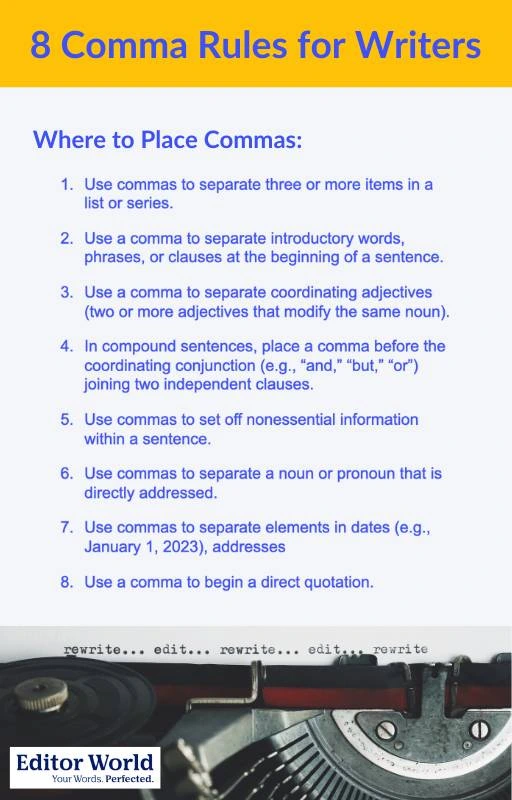8 Comma Rules for Writers
A comma is a punctuation mark used to show a brief pause or separation within a sentence. The comma helps to clarify the structure and meaning of statements. It indicates relationships between words, phrases, and clauses.
How a comma is used can vary depending on the context and the rules or guidelines being followed when writing. However, there are some general guidelines for comma placement, as discussed below.
Where to Place Commas
1. Use commas to separate three or more items in a list or series.• An example is: I need to buy pants, shirts, and shoes.
2. Use a comma to separate introductory words, phrases, or clauses at the beginning of a sentence.
• An example is: Before we went, we packed our bags.
3. Use a comma to separate coordinating adjectives (two or more adjectives that modify the same noun).
• An example is: She wore a beautiful, colorful dress.
4. In compound sentences, place a comma before the coordinating conjunction (e.g., “and,” “but,” “or”) joining two independent clauses.
• An example is: I like to surf, and he likes to run.
5. Use commas to set off nonessential information within a sentence.
• An example is: Josie, who is my student, is a talented writer.
6. Use commas to separate a noun or pronoun that is directly addressed.
• An example is: Thank you, Samantha, for carrying my bag.
7. Use commas to separate elements in dates (e.g., January 1, 2023), addresses (e.g., 123 Main Street, Philadelphia, PA), and large numbers (e.g., 2,000).
8. Use a comma to begin a direct quotation.
• An example is: She said, “Walk through the door and turn right.”
These are general guidelines for using commas, but specific rules may differ based on the style guide or grammatical conventions you’re following. Different writing styles, such as the APA style guide, the AP Stylebook, or the Chicago Manual of Style, may have specific guidelines regarding how commas should be used. It’s always a good idea to consult the style guide required or refer to the guidelines of the publication for more specific rules on using commas in different contexts.
The Oxford Comma
The Oxford comma, which is also known as a serial comma, is a comma used before the coordinating conjunction (“and” or “or”) in a list of three or more items. The serial comma is named because it is used in a series or sequence of items. The Oxford comma is named after the Oxford University Press, which traditionally advocated the use of a serial comma. Here's an example to illustrate how the Oxford comma is used and how it can impact statements:Without the Oxford comma : “Dedicated to my pets, Mina and Tom.” In this case, the reader might think that the pets’ names are Mina and Tom; however, this statement could also refer to three different parties: the pets, Mina, and Tom.
The next example, with the Oxford comma included, makes things more clear.
With the Oxford comma : “Dedicated to my pets, Mina, and Tom.” As you can see, the Oxford comma appears after “Mina” in the second example. Separating the three items in the list makes things clearer to the reader so it is easier to interpret the intended meaning.
The Oxford comma helps avoid potential ambiguity or confusion in sentences, particularly when the items in the list themselves contain combinations (in this case, people and animals). While the use of the Oxford comma depends on the writer’s style and preference, it is commonly used in American English. In British English, its usage is often optional.
Some style guides, such as The Chicago Manual of Style, recommend the use of the serial comma for purposes of clarity and consistency. However, the use of the Oxford comma is discouraged or omitted in some style guides (e.g., the AP Stylebook) unless it is necessary for clarity. Ultimately, it’s important for you as a writer to follow the specific style guide or publication guidelines you are writing for. It is also important to be consistent in whether you do or do not use the serial comma.
Comma Splices
A comma splice is a grammatical error that occurs when two independent clauses (complete sentences) are incorrectly joined together with only a comma, without including a coordinating conjunction or appropriate punctuation. This results in the two clauses being improperly combined into a single sentence.• An example is: “I finished the article, I printed it.” In this example, “I finished the article” and “I printed it” are two independent clauses that could be two separate sentences. However, they are incorrectly joined using only a comma without a coordinating conjunction, and this creates a comma splice.
To correct the comma splice, you can use a variety of methods, such as:
• Separate the clauses into two sentences: “I finished the article. I printed it.”
• Use a coordinating conjunction (e.g., “and” or “so”) to join the clauses: “I finished the article, and I printed it.”
Comma vs. Semicolon (;)
The comma (,) and semicolon (;) are punctuation marks used to indicate pauses and separate elements within a sentence. However, the two have different functions and are used differently. Here’s a description of when you should use a semicolon (;):• Joining independent clauses that are related without using a coordinating conjunction. For example: “He studied all week; he was prepared for the test.”
• Separating items in a list when the items themselves contain commas. For example: “The guests included Sophia Hsu, a lawyer from Pittsburgh; Cameron Clark, a scientist from Boston; and Dr. Randi Brown, a professor from New York.”
In general, a comma indicates a shorter pause and is used to separate elements within a sentence. A semicolon, on the other hand, indicates a slightly longer pause and is used to connect closely related independent clauses. The specific usage of commas and semicolons varies depending on the style guide or grammatical rules being followed.
